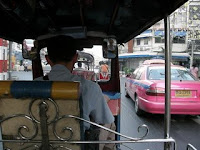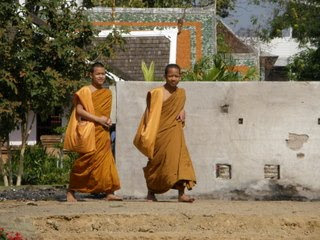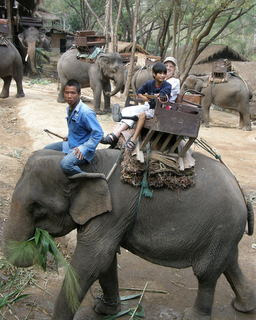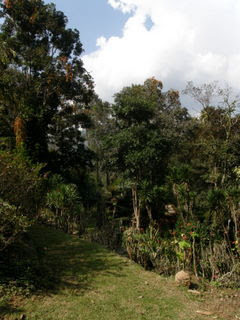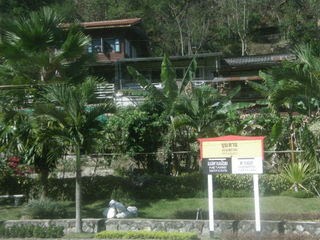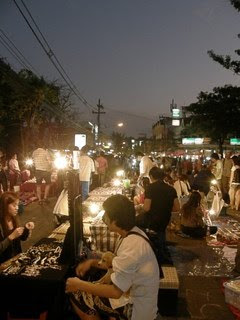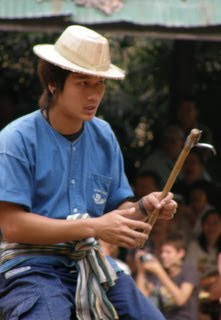skip to main | skip to sidebar
Maybe we really shouldn’t have bargained so hard with the guy, we’re thinking, as our Emirates flight into Paris from Bangkok (via Dubai) descends over the glittering panorama below. But it’s just one of so many fascinating memories left over from our recently completed month-long trip to Thailand — where we escaped the unusually biting January cold and snowfalls our friends were suffering here in the Perigord.
The three-wheeled Tuk-Tuk is urban Thailand’s cut rate, people-carrier, the drivers of which race through Chiang Mai and Bangkok’s congested streets dodging taxis, buses, cars, trucks, and — if they’re lucky — pedestrians. Marked crossings, unless accompanied by a light, don’t count, so you simply plunge ahead whenever there seems to be a modest break in the flow, raise a firm hand, keep on moving, and have faith they will stop or at least avoid hitting you.
BANGKOK: No longer the dark, sweaty, mysterious far east we gawked at in those Charlie Chan films of the 30s and 40s (except in spots) — or even what Dan experienced in the 50s, shipping out in the merchant marine to places like Manila, Hong Kong or Yokohama — the city of Bangkok is modernising fast, much like Malaysia’s Kuala Lumpur, that we visited last year.
The dominant images, are those of a developed country, with the past rapidly giving way to five-story, three-block-long shopping malls that feature high-end Thai fashions, the finest silks and superbly made handicrafts of all kinds, right next to kerbside stands with cheap Disney character knockoff T-shirts, fake Omega watches or bogus gemstones. And ubiquitous eating places, sidewalk and otherwise, for Thais are constant grazers, nibbling at all hours of the day or night. (Though few are fat.) In spite of remaining areas of obvious poverty and so many folk working long hours to scratch out a living, varied, healthy, local, low cost food seems, fortunately, to be available to all. Western style restaurants, however are comparatively expensive.
BUDDHIST MONKS are seen everywhere, of course, and for the 90 to 95 percent of Thais who are Buddhist, a parent’s fondest hope is that their sons will “take the orange robe,” at least for a minimum two week period. A rite of passage, this brings merit and good fortune to the whole family.
 HATS OFF AND STAND AT ATTENTION FOR THE NATIONAL ANTHEM.** This is played daily over loudspeakers at various times (often at 6 pm), at which everyone stops whatever they are doing, takes off a hat if they’re wearing one, and maybe joins in the singing. It’s also played before any film that’s screened in theaters (we saw Avitar while in Chaing Mai). On our last day in Bangkok we were watching a few hundred people “jazzersizing” to recorded music in Lumpini Park when the anthem came on. Everyone stopped. Even the elephants respected the tradition!
HATS OFF AND STAND AT ATTENTION FOR THE NATIONAL ANTHEM.** This is played daily over loudspeakers at various times (often at 6 pm), at which everyone stops whatever they are doing, takes off a hat if they’re wearing one, and maybe joins in the singing. It’s also played before any film that’s screened in theaters (we saw Avitar while in Chaing Mai). On our last day in Bangkok we were watching a few hundred people “jazzersizing” to recorded music in Lumpini Park when the anthem came on. Everyone stopped. Even the elephants respected the tradition!
 Thailand is a constitutional monarchy. Huge billboard photos of the king and queen are to be seen everywhere, from inside wats, in public parks and along the main city highways. Not too surprising as the present king (who’s been ill for some time) has apparently long had the interests of his people at heart and is highly revered.
Thailand is a constitutional monarchy. Huge billboard photos of the king and queen are to be seen everywhere, from inside wats, in public parks and along the main city highways. Not too surprising as the present king (who’s been ill for some time) has apparently long had the interests of his people at heart and is highly revered.
 EVERYDAY LIFE AND CULTURE: Mostly we were content absorbing the everyday life of Chiang Mai for three weeks - walking around the city exploring local markets and numerous eating places, watching street entertainment,visiting all those fabulous wats, strolling by the river and taking afternoon tea at a riveside tea house, riding the local buses (ancient covered pickup trucks), going to the cinema, watching Seth play basketball at school and even joining an expat pub quiz team for an evening.
EVERYDAY LIFE AND CULTURE: Mostly we were content absorbing the everyday life of Chiang Mai for three weeks - walking around the city exploring local markets and numerous eating places, watching street entertainment,visiting all those fabulous wats, strolling by the river and taking afternoon tea at a riveside tea house, riding the local buses (ancient covered pickup trucks), going to the cinema, watching Seth play basketball at school and even joining an expat pub quiz team for an evening.
 Sometimes we just chilled out on Barbara’s lovely parasol shaded terrace. Well, maybe just till Seth came home from school and dragged us up to play badminton or to admire his skill at basketball, press-ups or skateboarding.
Sometimes we just chilled out on Barbara’s lovely parasol shaded terrace. Well, maybe just till Seth came home from school and dragged us up to play badminton or to admire his skill at basketball, press-ups or skateboarding.
 NATURE: Our host, Barbara took us on a long forest walk alongside an impressive series of waterfalls and to two beautiful botanical gardens.
NATURE: Our host, Barbara took us on a long forest walk alongside an impressive series of waterfalls and to two beautiful botanical gardens.
 Our 12-hour, 480 mile, train ride back to Bangkok (cost about $15. each!) gave us interesting views of mountain forests and rice paddy covered plains.
Our 12-hour, 480 mile, train ride back to Bangkok (cost about $15. each!) gave us interesting views of mountain forests and rice paddy covered plains.
 We did however witness a giant monitor lizard (Hia) near Bangkok’s Lumpini Park lake, which was busy fending off a dog that had taken it upon himself to attack the poor creature; fortunately, the lizard quickly escaped into the water. These monitors are apparently becoming abundant in Bangkok, with around 200 now residing in every district in the city.
We did however witness a giant monitor lizard (Hia) near Bangkok’s Lumpini Park lake, which was busy fending off a dog that had taken it upon himself to attack the poor creature; fortunately, the lizard quickly escaped into the water. These monitors are apparently becoming abundant in Bangkok, with around 200 now residing in every district in the city.
 SHOPPING: While we browsed endless markets — the Sunday Walking Street Market, the Saturday Walking Street Market, The everyday Night Bazaar, the Wararot Market (all immensely crowded but loads of fun) we only bought a few things (couldn’t fit much in our suitcases). Dan purchased five marionettes (made in Burma, as most are), and we acquired a wonderfully colorful bedspread, crafted by one of the hill tribe peoples, the Hmong.
SHOPPING: While we browsed endless markets — the Sunday Walking Street Market, the Saturday Walking Street Market, The everyday Night Bazaar, the Wararot Market (all immensely crowded but loads of fun) we only bought a few things (couldn’t fit much in our suitcases). Dan purchased five marionettes (made in Burma, as most are), and we acquired a wonderfully colorful bedspread, crafted by one of the hill tribe peoples, the Hmong.
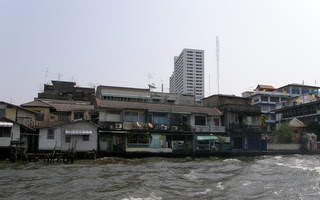 BACK IN BANGKOK for two days before our flight home, we rode the sky train to a huge modern shopping mall, took a quick look and beat a hasty retreat. We did however enjoy an evening wandering the vast night bazaar - and a morning in Chinatown. We took the public boat upriver to Pier #5 ( a 20 minute ride — 30 baht… about .90 cents) then walked a few blocks to a scene that, except for the modern gizmos, clothing and a zillion cheap Chinese toys and knick-knacks for sale, came closest to those 30s or 40s images. A three-foot space on the sidewalk in front of stalls, stands and shops jammed against the buildings was barely enough to let throngs of shoppers crowd along between these and other stands, or tables, set out for eating right next to (and in) the street. Between hawkers pushing their food or merchandise, or suppliers pushing through the multitude with carts, wheelbarrows or shoulder-carried bundles of goods, there seemed an easy relaxation to it all, for Thai are invariably friendly, and almost everyone smiles a lot. Including at strangers.
BACK IN BANGKOK for two days before our flight home, we rode the sky train to a huge modern shopping mall, took a quick look and beat a hasty retreat. We did however enjoy an evening wandering the vast night bazaar - and a morning in Chinatown. We took the public boat upriver to Pier #5 ( a 20 minute ride — 30 baht… about .90 cents) then walked a few blocks to a scene that, except for the modern gizmos, clothing and a zillion cheap Chinese toys and knick-knacks for sale, came closest to those 30s or 40s images. A three-foot space on the sidewalk in front of stalls, stands and shops jammed against the buildings was barely enough to let throngs of shoppers crowd along between these and other stands, or tables, set out for eating right next to (and in) the street. Between hawkers pushing their food or merchandise, or suppliers pushing through the multitude with carts, wheelbarrows or shoulder-carried bundles of goods, there seemed an easy relaxation to it all, for Thai are invariably friendly, and almost everyone smiles a lot. Including at strangers.
 OK, now we’re back in Paris, where, before catching the train home, we got to spend a lovely day wandering the city, bought a small watercolor from one of the artists offering their work in Montmartre . We got into a conversation with her and she came way down on the price of her painting when she learned that Dan was an animator, because “one of my father’s good friends was an animator from Poland, and I have a whole drawer full of his work.” And ended with a fine French dinner with our friend Robert, who generously houses us when we visit the City of Light.
OK, now we’re back in Paris, where, before catching the train home, we got to spend a lovely day wandering the city, bought a small watercolor from one of the artists offering their work in Montmartre . We got into a conversation with her and she came way down on the price of her painting when she learned that Dan was an animator, because “one of my father’s good friends was an animator from Poland, and I have a whole drawer full of his work.” And ended with a fine French dinner with our friend Robert, who generously houses us when we visit the City of Light.
And…. Oh, that question about what you say to the tuk-tuk driver when he asks for 300 baht.
You know it should be 60 but there are lots of other potential riders around, and he might just decide to wait for who'll pay over the odds. So you say “No, we’ll pay 100.” And when he quickly lowers the price to 200, you stand firm. Even after he says 150. Then 140. And when he finally agrees to 100 and you pile aboard, he races through traffic like a madman for the 20 minute ride, nearly colliding with other vehicles and almost running down pedestrians - and we hold on tight and wonder if this is his revenge for us being such skinflints.
And finally in our best (and only Thai) we say“Khob kun ka“ with a smile and a slight bow of the head while holding our hands together as if in prayer. And we remember with pleasure the returning smile and gesture of acknowledgement which always followed.
Thank you very much.
Thailand
Wednesday, February 17, 2010
JEANNE AND DAN'S THAILAND TRIP - JANUARY 2010
WHAT DO YOU SAY TO THE TUK-TUK DRIVER WHEN HE DEMANDS 300 BAHT FOR A 60 BAHT FARE?
Maybe we really shouldn’t have bargained so hard with the guy, we’re thinking, as our Emirates flight into Paris from Bangkok (via Dubai) descends over the glittering panorama below. But it’s just one of so many fascinating memories left over from our recently completed month-long trip to Thailand — where we escaped the unusually biting January cold and snowfalls our friends were suffering here in the Perigord.
The three-wheeled Tuk-Tuk is urban Thailand’s cut rate, people-carrier, the drivers of which race through Chiang Mai and Bangkok’s congested streets dodging taxis, buses, cars, trucks, and — if they’re lucky — pedestrians. Marked crossings, unless accompanied by a light, don’t count, so you simply plunge ahead whenever there seems to be a modest break in the flow, raise a firm hand, keep on moving, and have faith they will stop or at least avoid hitting you.
BANGKOK: No longer the dark, sweaty, mysterious far east we gawked at in those Charlie Chan films of the 30s and 40s (except in spots) — or even what Dan experienced in the 50s, shipping out in the merchant marine to places like Manila, Hong Kong or Yokohama — the city of Bangkok is modernising fast, much like Malaysia’s Kuala Lumpur, that we visited last year.
The dominant images, are those of a developed country, with the past rapidly giving way to five-story, three-block-long shopping malls that feature high-end Thai fashions, the finest silks and superbly made handicrafts of all kinds, right next to kerbside stands with cheap Disney character knockoff T-shirts, fake Omega watches or bogus gemstones. And ubiquitous eating places, sidewalk and otherwise, for Thais are constant grazers, nibbling at all hours of the day or night. (Though few are fat.) In spite of remaining areas of obvious poverty and so many folk working long hours to scratch out a living, varied, healthy, local, low cost food seems, fortunately, to be available to all. Western style restaurants, however are comparatively expensive.
CHIANG MAI: Most of our time was spent in this attractive provincial city, in the northern part of the country (a metro area population of one million; Bangkok has 10 million).
We were graciously and generously hosted by Barbara, an old friend from Santa Cruz who has lived there (and in Vietnam, Laos, Pakistan and other Eastern nations for many years), and from where she roams as a consultant on HIV prevention to various governments and organizations. And where we also enjoyed the hospitality (and delicious cooking) of Barbara’s Lao friend and housekeeper, Tuy, as well as the feisty playfulness of Barbara’s adopted son, Seth, age 12.
Norman, a charming friend of a U.S. friend, and resident in Thailand for 40 years, also tooted us around several times, including introducing us to a some typical Thai eating places and chauffeuring us up to the unmissible Doi Suthep temple with its hillside view of the whole city spread out below.
And what did we do, see and experience in Chiang Mai? (Aside from the traffic, the streams of tuk-tuks and motorcycles… maybe half of whose drivers wore no helmets and often carried one, two, or even three others on the rear… including small children, and infants in their mother’s arms).
Well, we saw:
Well, we saw:
WATS (Buddhist temples). So many in Chiang Mai that we lost count. All feature golden Buddhas ornate carvings, spires, gold ornamentation, dragons and other decoration that we don’t need to describe further, because Jeanne’s photos tell the story.
BUDDHIST MONKS are seen everywhere, of course, and for the 90 to 95 percent of Thais who are Buddhist, a parent’s fondest hope is that their sons will “take the orange robe,” at least for a minimum two week period. A rite of passage, this brings merit and good fortune to the whole family.
The status of monkhood can also be attributed to ancient trees. The wrapping of their trunks in saffron cloth protects them from being felled. Three cheers for the Buddhist environmentalists.
ELEPHANTS: At a sanctuary-compound and training center, where 70 of these great beasts have learned to perform, give rides to tourists (Jeanne and Seth took one; Dan took their photos), eat out of people’s hands, and paint incredible pictures. Really - we watched them do it! The great thing is that both the elephants and their keepers (mahouts) all seemed happy. You can even take a course there to learn to care for an elephant and become an honorary mahout yourself.
 HATS OFF AND STAND AT ATTENTION FOR THE NATIONAL ANTHEM.** This is played daily over loudspeakers at various times (often at 6 pm), at which everyone stops whatever they are doing, takes off a hat if they’re wearing one, and maybe joins in the singing. It’s also played before any film that’s screened in theaters (we saw Avitar while in Chaing Mai). On our last day in Bangkok we were watching a few hundred people “jazzersizing” to recorded music in Lumpini Park when the anthem came on. Everyone stopped. Even the elephants respected the tradition!
HATS OFF AND STAND AT ATTENTION FOR THE NATIONAL ANTHEM.** This is played daily over loudspeakers at various times (often at 6 pm), at which everyone stops whatever they are doing, takes off a hat if they’re wearing one, and maybe joins in the singing. It’s also played before any film that’s screened in theaters (we saw Avitar while in Chaing Mai). On our last day in Bangkok we were watching a few hundred people “jazzersizing” to recorded music in Lumpini Park when the anthem came on. Everyone stopped. Even the elephants respected the tradition!  Thailand is a constitutional monarchy. Huge billboard photos of the king and queen are to be seen everywhere, from inside wats, in public parks and along the main city highways. Not too surprising as the present king (who’s been ill for some time) has apparently long had the interests of his people at heart and is highly revered.
Thailand is a constitutional monarchy. Huge billboard photos of the king and queen are to be seen everywhere, from inside wats, in public parks and along the main city highways. Not too surprising as the present king (who’s been ill for some time) has apparently long had the interests of his people at heart and is highly revered. Not so his son the crown prince, a playboy whose supposedly lurid private life is regularly (though not publicly) gossiped about. Disrespecting the monarchy in public is a big no-no, and can land one in the pokey for up to 15 years. (Though the king has pardoned most offenders.)
For some time the country has been beset by coups and power struggles, currently exemplified by that between a couple of powerful media tycoons, one of whom, an exiled prime minister, may, some fear, soon attempt to seize control again. Followers of these moguls are known by the colors they wear, red or yellow. The following website provides at least brief insight: http://www.thaizer.com/politics/who-are-the-yellow-shirts-and-red-shirts/
 EVERYDAY LIFE AND CULTURE: Mostly we were content absorbing the everyday life of Chiang Mai for three weeks - walking around the city exploring local markets and numerous eating places, watching street entertainment,visiting all those fabulous wats, strolling by the river and taking afternoon tea at a riveside tea house, riding the local buses (ancient covered pickup trucks), going to the cinema, watching Seth play basketball at school and even joining an expat pub quiz team for an evening.
EVERYDAY LIFE AND CULTURE: Mostly we were content absorbing the everyday life of Chiang Mai for three weeks - walking around the city exploring local markets and numerous eating places, watching street entertainment,visiting all those fabulous wats, strolling by the river and taking afternoon tea at a riveside tea house, riding the local buses (ancient covered pickup trucks), going to the cinema, watching Seth play basketball at school and even joining an expat pub quiz team for an evening. Sometimes we just chilled out on Barbara’s lovely parasol shaded terrace. Well, maybe just till Seth came home from school and dragged us up to play badminton or to admire his skill at basketball, press-ups or skateboarding.
Sometimes we just chilled out on Barbara’s lovely parasol shaded terrace. Well, maybe just till Seth came home from school and dragged us up to play badminton or to admire his skill at basketball, press-ups or skateboarding. We had a great night out, with Barbara and Seth, at an outdoor dinner (mainly for tourists but also popular with local Thais) followed by wonderful Thai dancing.
The evening concluded with the ascension of Sky Lanterns, meter-high paper balloons which, propelled by small, lighted fuel pots, sail heavenward and bring good luck to the senders.
The main cultural highlight was a visit to Chiang Mai’s Tribal Museum, displaying wonderful artefacts, and the history of the more than 700,000 people living in the 7 major tribes (plus many offshoots) inhabiting mainly the northern part of the country. We probably learned more about Thailand’s hill tribe people in the few hours we spent here than we would have by taking an expensive tourist trek into the mountains beyond. (Unfortunately the museum didn't allow photos, but log onto http://www.thailine.com/thailand/english/hill-e/hilltr-e.htm. if the subject interests you.)
 NATURE: Our host, Barbara took us on a long forest walk alongside an impressive series of waterfalls and to two beautiful botanical gardens.
NATURE: Our host, Barbara took us on a long forest walk alongside an impressive series of waterfalls and to two beautiful botanical gardens.  Our 12-hour, 480 mile, train ride back to Bangkok (cost about $15. each!) gave us interesting views of mountain forests and rice paddy covered plains.
Our 12-hour, 480 mile, train ride back to Bangkok (cost about $15. each!) gave us interesting views of mountain forests and rice paddy covered plains. We missed out on lazy days on long sandy beaches and on seeing the tigers, gibbons, other exotic wildlife that Thailand is famous for. (This would have involved more forward planning and way over-stretched our limited budget).
 We did however witness a giant monitor lizard (Hia) near Bangkok’s Lumpini Park lake, which was busy fending off a dog that had taken it upon himself to attack the poor creature; fortunately, the lizard quickly escaped into the water. These monitors are apparently becoming abundant in Bangkok, with around 200 now residing in every district in the city.
We did however witness a giant monitor lizard (Hia) near Bangkok’s Lumpini Park lake, which was busy fending off a dog that had taken it upon himself to attack the poor creature; fortunately, the lizard quickly escaped into the water. These monitors are apparently becoming abundant in Bangkok, with around 200 now residing in every district in the city.  SHOPPING: While we browsed endless markets — the Sunday Walking Street Market, the Saturday Walking Street Market, The everyday Night Bazaar, the Wararot Market (all immensely crowded but loads of fun) we only bought a few things (couldn’t fit much in our suitcases). Dan purchased five marionettes (made in Burma, as most are), and we acquired a wonderfully colorful bedspread, crafted by one of the hill tribe peoples, the Hmong.
SHOPPING: While we browsed endless markets — the Sunday Walking Street Market, the Saturday Walking Street Market, The everyday Night Bazaar, the Wararot Market (all immensely crowded but loads of fun) we only bought a few things (couldn’t fit much in our suitcases). Dan purchased five marionettes (made in Burma, as most are), and we acquired a wonderfully colorful bedspread, crafted by one of the hill tribe peoples, the Hmong.MASSAGE. Yep, we indulged four or five times. Massage parlors are everywhere, often with chairs spilling out onto the sidewalks to catch passing trade. Some (mostly in Bangkok) obviously cater to the sex trade, but most are quite legit The neighbourhood one Barbara recommended was staffed by highly skilled women (and one man), who provided, for fees averaging 200 baht — around $6.00 — hour-long full body oil massage, Thai massage (vigorous muscle stretching), foot massage, or herbal massage (compression with hot, scented towels, combined with regular Thai massage).
Yes, we know, we know… it’s a hard life…but we did do an awful lot of walking to earn them.
Yes, we know, we know… it’s a hard life…but we did do an awful lot of walking to earn them.
MEDICAL CARE. The day before returning to Bangkok, Jeanne came down with an unexplained allergic reaction on both lower legs. No sickness, no pain, no itching, just big blotchy rashes. A Sunday morning trip to Chaing Mai’s main hospital — a model of modern and efficient medical practice — brought a consultation with a very competent doctor, plus medication. Total cost, about $22. Now gone, we still don’t know what brought on the reaction. Due to the doctor’s recommendation that she travel with her legs elevated our travel insurance company paid to upgrade Jeanne to business class for the flight home, and taking no chances insisted on a wheelchair for her at the airports. Due to the fact that an upgrade cost almost as much as our combined return flights, Dan remained in economy, but we both enjoyed the benefits of business class lounges and speedy transit through security and immigration - and the taxis provided at each end of the journey.
 BACK IN BANGKOK for two days before our flight home, we rode the sky train to a huge modern shopping mall, took a quick look and beat a hasty retreat. We did however enjoy an evening wandering the vast night bazaar - and a morning in Chinatown. We took the public boat upriver to Pier #5 ( a 20 minute ride — 30 baht… about .90 cents) then walked a few blocks to a scene that, except for the modern gizmos, clothing and a zillion cheap Chinese toys and knick-knacks for sale, came closest to those 30s or 40s images. A three-foot space on the sidewalk in front of stalls, stands and shops jammed against the buildings was barely enough to let throngs of shoppers crowd along between these and other stands, or tables, set out for eating right next to (and in) the street. Between hawkers pushing their food or merchandise, or suppliers pushing through the multitude with carts, wheelbarrows or shoulder-carried bundles of goods, there seemed an easy relaxation to it all, for Thai are invariably friendly, and almost everyone smiles a lot. Including at strangers.
BACK IN BANGKOK for two days before our flight home, we rode the sky train to a huge modern shopping mall, took a quick look and beat a hasty retreat. We did however enjoy an evening wandering the vast night bazaar - and a morning in Chinatown. We took the public boat upriver to Pier #5 ( a 20 minute ride — 30 baht… about .90 cents) then walked a few blocks to a scene that, except for the modern gizmos, clothing and a zillion cheap Chinese toys and knick-knacks for sale, came closest to those 30s or 40s images. A three-foot space on the sidewalk in front of stalls, stands and shops jammed against the buildings was barely enough to let throngs of shoppers crowd along between these and other stands, or tables, set out for eating right next to (and in) the street. Between hawkers pushing their food or merchandise, or suppliers pushing through the multitude with carts, wheelbarrows or shoulder-carried bundles of goods, there seemed an easy relaxation to it all, for Thai are invariably friendly, and almost everyone smiles a lot. Including at strangers. OK, now we’re back in Paris, where, before catching the train home, we got to spend a lovely day wandering the city, bought a small watercolor from one of the artists offering their work in Montmartre . We got into a conversation with her and she came way down on the price of her painting when she learned that Dan was an animator, because “one of my father’s good friends was an animator from Poland, and I have a whole drawer full of his work.” And ended with a fine French dinner with our friend Robert, who generously houses us when we visit the City of Light.
OK, now we’re back in Paris, where, before catching the train home, we got to spend a lovely day wandering the city, bought a small watercolor from one of the artists offering their work in Montmartre . We got into a conversation with her and she came way down on the price of her painting when she learned that Dan was an animator, because “one of my father’s good friends was an animator from Poland, and I have a whole drawer full of his work.” And ended with a fine French dinner with our friend Robert, who generously houses us when we visit the City of Light. And…. Oh, that question about what you say to the tuk-tuk driver when he asks for 300 baht.
You know it should be 60 but there are lots of other potential riders around, and he might just decide to wait for who'll pay over the odds. So you say “No, we’ll pay 100.” And when he quickly lowers the price to 200, you stand firm. Even after he says 150. Then 140. And when he finally agrees to 100 and you pile aboard, he races through traffic like a madman for the 20 minute ride, nearly colliding with other vehicles and almost running down pedestrians - and we hold on tight and wonder if this is his revenge for us being such skinflints.
Even though bargaining is the name of the game in Thailand (as in many places), it’s best to remember what one hard-working guy at a craft stand whose work we were considering said, as we asked for a lower price: “Come on now, 50 baht doesn’t’t mean anything to you, but it means a great deal to me.”
So with a few special photos we pay our respects to the smiling, friendly, hardworking, courteous people of Thailand.
And finally in our best (and only Thai) we say“Khob kun ka“ with a smile and a slight bow of the head while holding our hands together as if in prayer. And we remember with pleasure the returning smile and gesture of acknowledgement which always followed.
Thank you very much.
Subscribe to: Posts (Atom)
